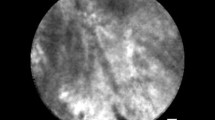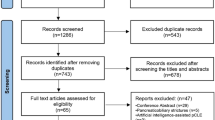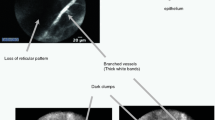Abstract
Background and Study Aim
The incidence of cholangiocarcinoma (CCA) in primary sclerosing cholangitis (PSC) ranges between 7 and 14 %. Despite using multiple tissue sampling modalities, detection of CCA remains a challenge. Probe-based confocal laser endomicroscopy (pCLE) has been utilized to visualize subepithelial biliary mucosa in patients with indeterminate strictures. We assessed the technical feasibility and operating characteristics of pCLE in a cohort of PSC patients with dominant biliary strictures (DS).
Patients and Methods
This was a chart review of a prospectively maintained database at a single tertiary referral center of 15 PSC patients with 21 dominant stenoses undergoing pCLE. A data collection sheet included demographics, ERCP, cholangioscopy, pCLE (Miami criteria), tissue sampling results, and follow-up to 12 months or liver transplantation. Operating characteristics for pCLE and ERCP tissue sampling were calculated.
Results
Sufficient visualization of DS by pCLE was achieved in 20/21 (95 %). pCLE sensitivity, specificity, PPV, and NPV were 100 % (95 % CI 19.3–100 %), 61.1 % (95 % CI 35.8–82.6 %), 22.2 % (95 % CI 3.5–59.9 %), and 100 % (95 % CI 71.3–100 %), respectively, in detecting neoplasia. In comparison, concomitant tissue sampling yielded sensitivity, specificity, PPV, and NPV of 0 % (95 % CI 0–80.7 %), 94.4 % (95 % CI 72.6–99.1 %), 0 % (95 % CI 0–83.5 %), and 89.5 % (95 % CI 66.8–98.4 %), respectively.
Conclusions
pCLE achieves a high technical success rate in patients with PSC and DS. This single center, small series, suggests that pCLE may have a high sensitivity and negative predictive value to exclude neoplasia. If verified in larger prospective studies, the technology may be utilized to risk stratify dominant strictures in patients with PSC.





Similar content being viewed by others
Abbreviations
- CCA:
-
Cholangiocarcinoma
- DS:
-
Dominant biliary stricture
- PPV:
-
Positive predictive value
- PSC:
-
Primary sclerosing cholangitis
- pCLE:
-
Probe-based confocal laser endomicroscopy
- NPV:
-
Negative predictive value
References
Boberg K, Lind G. Primary sclerosing cholangitis and malignancy. Best Pract Res Clin Gastroenterol. 2011;25:753–764.
Rösch T, Hofrichter K, Frimberger E, et al. ERCP or EUS for tissue diagnosis of biliary strictures? A prospective comparative study. Gastrointest Endosc. 2004;60:390–396.
Ponchon T, Gagnon P, Berger F, et al. Value of endobiliary brush cytology and biopsies for the diagnosis of malignant bile duct stenosis: results of a prospective study. Gastrointest Endosc. 1995;42:565–572.
Schöfl R, Haefner M, Wrba F, et al. Forceps biopsy and brush cytology during endoscopic retrograde cholangiopancreatography for the diagnosis of biliary stenoses. Scand J Gastroenterol. 1997;32:363–368.
Bangarulingam SY, Bjornsson E, Enders F, et al. Long-term outcomes of positive fluorescence in situ hybridization tests in primary sclerosing cholangitis. Hepatology. 2010;51:174–180.
Barr Fritcher EG, Kipp BR, Voss JS, et al. Primary sclerosing cholangitis patients with serial polysomy fluorescence in situ hybridization results are at increased risk of cholangiocarcinoma. Am J Gastroenterol. 2011;106:2023–2028.
Awadallah NS, Chen YK, Piraka C, et al. Is there a role for cholangioscopy in patients with primary sclerosing cholangitis? Am J Gastroenterol. 2006;101:284–291.
Meining A, Chen YK, Pleskow D, et al. Direct visualization of indeterminate pancreatobiliary strictures with probe based confocal laser endomicroscopy: a multicenter experience. Gastrointest Endosc. 2011;74:961–968.
Meining A, Shah RJ, Slivka A, et al. Classification of probe-based confocal laser endomicroscopy findings in pancreaticobiliary strictures. Endoscopy. 2012;44:251–257.
Burak K, Angulo P, Pasha TM, et al. Incidence and risk factors for cholangiocarcinoma in primary sclerosing cholangitis. Am J Gastroenterol. 2004;99:523–526.
Rosen CB, Nagorney DM. Cholangiocarcinoma complicating primary sclerosing cholangitis. Semin Liver Dis. 1991;11:26–30.
Razumilava N, Gores G. Cancer surveillance in patients with primary sclerosing cholangitis. Hepatology. 2011;54:1842–1852.
Khan SA, Thomas HC, Davidson BR, et al. Cholangiocarcinoma. Lancet. 2005;366:1303–1314.
Ahrendt SA, Nakeeb A, Pitt HA. Cholangiocarcinoma. Clin Liver Dis. 2001;5:191–218.
Rudolph G, Gotthardt D, Kloeters-Plachky P, et al. In PSC with dominant bile duct stenosis, IBD is associated with an increase of carcinomas and reduced survival. J Hepatol. 2010;53:313–317.
Chen YK, Pleskow DK. SpyGlass single-operator peroral cholangiopancreatoscopy system for the diagnosis and therapy of bile-duct disorders: a clinical feasibility study (with video). Gastrointest Endosc. 2007;65:832–841.
Caillol F, Filoche B, Gaidhane M, Kahaleh M. Refined probe-based confocal laser endomicroscopy classification for biliary strictures: the Paris Classification. Dig Dis Sci. 2013;2533–2535. doi:10.1007/s10620-012-2533-5.
Giovannini M, Bories E, Monges G, et al. Results of a phase I-II study on intraductal confocal microscopy (IDCM) in patients with common bile duct (CBD) stenosis. Surg Endosc. 2011;25:2247–2253.
Acknowledgments
The authors wish to express our deepest appreciation for the invaluable contributions to this series of our former mentor and colleague Yang K. Chen, MD. His pioneering work in the area of biliary imaging remains an inspiration and benchmark for our own aspirations.
Conflict of interest
Dr. Shah is a consultant for Cook Endoscopy and Boston Scientific, Inc. and has received unrestricted educational grants from Mauna Kea Technologies, Inc. and Cook Endoscopy and Boston Scientific, Inc. Dr. Yen and Dr. Heif have none to declare.
Author information
Authors and Affiliations
Corresponding author
Rights and permissions
About this article
Cite this article
Heif, M., Yen, R.D. & Shah, R.J. ERCP with Probe-Based Confocal Laser Endomicroscopy for the Evaluation of Dominant Biliary Stenoses in Primary Sclerosing Cholangitis Patients. Dig Dis Sci 58, 2068–2074 (2013). https://doi.org/10.1007/s10620-013-2608-y
Received:
Accepted:
Published:
Issue Date:
DOI: https://doi.org/10.1007/s10620-013-2608-y




